Global Market Comments
November 26, 2018
Fiat Lux
Featured Trade:
(THE MARKET OUTLOOK FOR THE WEEK AHEAD, or ARE WE IN OR OUT?)
(FB), (AAPL), (AMZN), (NFLX),
(GOOG), (SPY), (TLT), (USO), (UNG), (ROM)
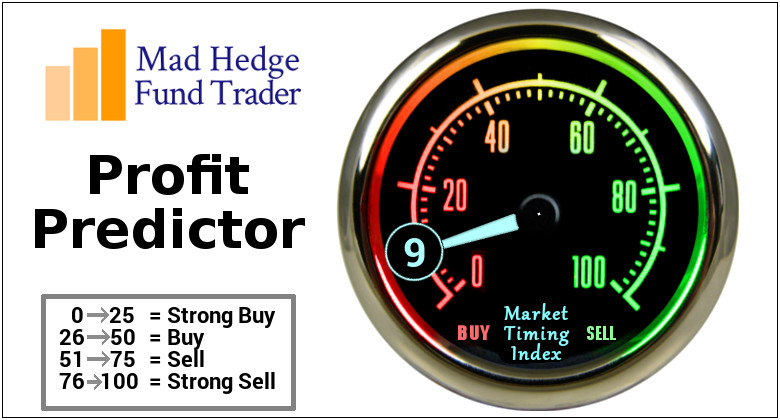
Global Market Comments
November 26, 2018
Fiat Lux
Featured Trade:
(THE MARKET OUTLOOK FOR THE WEEK AHEAD, or ARE WE IN OR OUT?)
(FB), (AAPL), (AMZN), (NFLX),
(GOOG), (SPY), (TLT), (USO), (UNG), (ROM)

Are we already in a recession or still safely out of one?
That is the question painfully vexing investors after the stock market action of the past seven weeks.
There is no doubt that the economic data has suddenly started to worsen, setting off recession alarms everywhere.
October Durable Goods were down a shocking 4.4%. Weekly Jobless Claims hit 224,000, continuing a grind up to a 4 ½ month high. Is the employment miracle ending? Goldman Sachs says growth is to drop below 2% in 2019, well below Obama era levels. Maybe that’s what the stock market crash is trying to tell us?
The Washington political situation continues to erode confidence by the day. We have already lost real estate, autos, energy, semiconductors, retailers, utilities, and banks. But as long as tech held up, everything was alright.
Now it’s not alright.
The tech selloff we have just seen was far steeper and faster than we saw in the 2008-2009 crash. You have to go all the way back to the Dotcom Bust 18 years ago to see the kind of price action we have just witnessed. The closely watched ProShares Ultra Technology Fund (ROM) has cratered from $123 to $83 in a heartbeat, off 32.5%.
Which begs the question: Are we already ten months into a bear market? Or is this all one big fake-out and there is one more leg up to go before the fat lady sings?
I vote for the latter.
If this is a new bear market, then it is the first one in history with the lead sectors, technology, biotechnology, and health care, announcing new all-time profits going in.
So, either Facebook (FB), Apple (AAPL), Amazon (AMZN), Netflix (NFLX), and Google (GOOG) are all about to announce big losses in coming quarters, which they aren’t, or the market is just plain wrong, which it is.
Which leads us to the next problem.
Markets can be wrong for quite a while which is why I cut my positions by half at the beginning of last week. To quote my old friend, John Maynard Keynes, “Markets can remain irrational longer than you can remain liquid,” who lists his entire fortune in the commodities markets during the Great Depression.
To see this all happen in October was expected. After all, markets always crash in October. To see it continue well into November is nearly unprecedented when the strongest seasonals of the year kick in. This was the worst Thanksgiving week since 2011 when we were still a wet dog shaking off the after-effects of the great crash.
There are a lot of hopes hanging on the November 29 G-20 Summit to turn things around which could hatch a surprise China trade deal when the leaders of the two great countries meet. The Chinese stock market hit a one month high last week on hopes of a positive outcome. Do they know something we don’t?
There were multiple crises in the energy world. You always find out who’s been swimming without a swimsuit when the tide goes out. James Cordier certainly suffered an ebb tide of tsunami proportions when his hedge fund blew up taking natural gas (UNG) down 20% in a day.
Cordier got away with naked call option selling for years until he didn’t. All of his investors were completely wiped out. I have always told followers to avoid this strategy for years. It’s picking up pennies in front of a steamroller. Same for naked puts selling too.
The Bitcoin crash continued slipping to $4,200. I always thought that this was an asset class created out of thin air to absorb excess global liquidity. Remove that liquidity and Bitcoin goes back to being thin air, which it is in the process of doing.
Oil (USO) got crushed again, down an incredible 35.06% in six weeks, from $77 a barrel all the way down to $50 as recession fears run rampant. Panic dumping of wrong-footed hedge fund longs accelerated the slide. They all had expected oil to rocket to $100 a barrel in the wake of the demise of the Iran Nuclear Deal and the economic sanctions that followed.
Apparently, Saudi Arabia’s deal with the US now is that they can chop up all the journalists they want at the expense of a $27 a barrel drop in the price of oil. That will cut their oil revenues by a stunning $97 billion a year. That’s one expensive journalist!
Watch the price of Texas tea carefully because a bottom there might signal a bottom for everything including tech stocks. And I don’t see oil falling much from here.
As for performance, Thanksgiving came early this year, at least in terms of the skinning, gutting, and roasting of my numbers. If you do this long enough, it happens. Every now and then, markets instill you with a strong dose of humility and this is one of those time.
My year to date return dropped to +25.72%, and chopping my trailing one-year return stands at 31.71%. November so far stands at a discouraging -3.91%. And this is against a Dow Average that is down -2.01% so far in 2018.
My nine-year return withered to +302.19%. The average annualized return retraced to +33.57%.
The upcoming week has some important real estate data coming. However, all eyes will be upon the Friday G-20 announcement from Buenos Aires. Will the trade war with China end, or get worse before it gets better?
Monday, November 26 at 8:30 EST, the Chicago Fed National Activity Index is published.
On Tuesday, November 27 at 9:00 AM, the all-important CoreLogic Case-Shiller National Home Price Index is out. It will be interesting to see how fast it is falling.
On Wednesday, November 28 at 8:30 AM, Q3 GDP is updated. How fast is it shrinking?
At 10:30 AM the Energy Information Administration announces oil inventory figures with its Petroleum Status Report.
Thursday, November 29 at 8:30 we get Weekly Jobless Claims which have been on a four-month uptrend. At 10:00 AM, October Pending Home Sales are printed.
On Friday, November 30, at 9:45 AM, the week ends with a whimper with the Chicago Purchasing Managers Index.
The Baker-Hughes Rig Count follows at 1:00 PM. At some point, we will get an announcement from the G-20 Summit of advanced industrial nations.
As for me, I drove through the first blizzard of the year over Donner Pass to finally crystal clear skies of San Francisco. Long-awaited drenching rains had finally cleansed the skies. Every Tahoe hotel was packed with Californians fleeing the smokey skies.
Good luck and good trading.
John Thomas
CEO & Publisher
The Diary of a Mad Hedge Fund Trader

Global Market Comments
October 25, 2018
Fiat Lux
Featured Trade:
(THE LAZY MAN’S GUIDE TO TRADING),
(ROM), (UXI), (BIB), (UYG),
(THE NEXT THING FOR THE FED TO BUY IS GOLD),
(GLD), (GOLD), (GDX), (ABX), (NEM)
Global Market Comments
July 5, 2018
Fiat Lux
Featured Trade:
(TRADING FOR THE NON-TRADER),
(ROM), (UXI), (UCC), (UYG)
Global Market Comments
July 2, 2018
Fiat Lux
Featured Trade:
(THE MARKET OUTLOOK FOR THE WEEK AHEAD, OR THE FUTURE IS HAPPENING FAST),
(HOG), (TLT), (ROM), (MU), (NVDA), (LRCX),
(SPY), (AMZN), (NFLX), (EEM), (UUP), (WBA),
(THE WORST TRADE IN HISTORY), (AAPL)
I feel like I'm living life in fast forward these days.
First we got a slap across the face with a wet mackerel on Monday with a 328 plunge in the Dow Average on yet another trade war escalation.
Harley Davidson (HOG) said it was moving a factory out of the country to bypass new European duties imposed in response to ours. If Harley is doing this you can bet there are 10,000 other companies thinking about it.
And even though robust economic growth should assure us that we remain in a new bear market for bonds, traders think otherwise. A 10-year Treasury bond (TLT) yield at 2.81% says that we're already in the next recession, we just don't know it yet.
As always happens with the ebb and flow of the trade war, technology got hammered. My favorite early retirement vehicle, the ProShares Ultra Technology 2X ETF (ROM), plunged some 11.19% to an even $100. Chip stocks such as Micron Technology (MU) and Lam Research (LRCX) get particularly hurt as China buys 80% of their processors from the U.S.
In the meantime, Tesla (TSLA) continues its phoenixlike rise from the ashes yet again, burning the shorts for the umpteenth time. The shares are now taking another run at a new all-time high. You would think people would learn but they don't. Einstein's definition of insanity is repeating the same thing over and over again and expecting a different result.
While bearish analysts predicted the imminent demise of the company, I saw a steady stream of trucks delivering new Tesla 3s from the Fremont factory while driving back from Los Angeles last weekend. Nothing beats on-the-ground research.
I'm sorry, but there is definite disconnect from reality with this company. The most hated company in America has produced the fifth best performing stock in over the past eight years, up more than 2,000%. I guess that's what happens when you disrupt big oil, Detroit, the U.S. dealer network, and the entire advertising industry all at the same time.
Interestingly, we caught three of the five best performers early on, including Tesla, NVIDIA (NVDA), and Netflix (NFLX).
Emerging markets (EEM) continue their death spiral, pummeled by the twin threats of trade wars and a soaring dollar (UUP). Most big emerging companies have their debt in dollars.
Sometimes you have to forget what you know to make money, and that has certainly been the case for me with emerging countries, where I spent a large part of my life.
The future is happening fast. Amazon (AMZN) single-handedly demolished the drug sector when it announced its takeover of online pharmacy company PillPack. The traditional brick-and-mortar retail pharmacy sector lost $9 billion in market capitalization just on the announcement. Walgreens (WBA) alone dropped a gut churning 10%.
If anyone can slash America's bloated health care bill it is Jeff Bezos. Just ask any former bookseller or toy maker.
And for a final middle finger salute to investors, the president said he wants to withdraw from the World Trade Organization, which the U.S. itself created after WWII. That means the United Nations is next on the chopping block.
America is rapidly becoming rogue nation No. 1, the next failed state. And failed states don't have great stock markets. Just check out the Somalia Stock Exchange.
They net of all of this is that the rest of the global economy is rolling over like the Bismarck, while the U.S. remains a sole beacon of strength. That's not good when half of S&P 500 earnings come from abroad.
However, that strength is based on a temporary one-time-only stimulus from massive deficit spending and corporate tax cuts that runs out of juice next year.
So keep tap dancing on the edge of the Grand Canyon. We'll miss you when you're gone. And before you ask, the best hedge in this kind of market is cash, which has huge option value that almost no one recognizes.
Despite all the chaos, uncertainty, and massive headline risk, I managed to tiptoe between the raindrops, keeping the Mad Hedge Fund Trader Alert Service performance just short of a new all-time high.
I closed out the month of June at a healthy 4.45%, my 2018 year-to-date performance rose to 24.82% and my 8 1/2-year return catapulted to 301.29%. The Averaged Annualized Return stands at 35.10%. The more narrowly focused Mad Hedge Technology Fund Trade Alert performance is annualizing now at an impressive 38.69%.
This coming holiday shortened week will be all about the jobs, jobs, jobs. Also, the Fed will raise interest rates by 25 basis points on Wednesday to an overnight rate of 2.00%.
On Monday, July 2, at 9:45 AM, the May PMI Manufacturing Index is out.
On Tuesday, July 3, at 10:00 AM, the May Factory Orders are published.
On Wednesday, July 4, U.S. markets are closed for Independence Day. I will be watching the fireworks display over New York's Hudson River from the top of a Midtown Manhattan skyscraper.
Thursday, July 5, sees a huge bunching up of data thanks to the Fourth of July. It leads with the ADP Employment Report for private sector jobs at 8:15 AM EST. The Weekly Jobless Claims follow at 8:30 AM EST, which saw a rise of 9,000 last week to 227,000. Also announced is the all-important 25 basis point interest rate rise from the Federal Reserve and the FOMC Minutes at 2:00 PM, a reading of what was discussed at the last Fed meeting.
On Friday, July 6 at 8:30 AM EST, we get the June Nonfarm Payroll Report. Then the Baker Hughes Rig Count is announced at 1:00 PM EST. I will be sipping a glass of champagne as I board the Queen Mary 2 at the Brooklyn Cruise Terminal. I look forward to all those who signed up for my Seminar at Sea.
As for me, I will be hurriedly packing for the 2018 Mad Hedge European Tour.
Unfortunately, traveling in the grand style of the 19th century Belle Epoque involves bringing 200 pounds of luggage.
Now where are those darn black dress socks? And why am I missing a stud for my formal shirt?
Good Luck and Good Trading.
Time to Get Off the Merry-Go-Round
What if you want to be a little more aggressive with your investment strategy, say twice as aggressive? What if markets don't deliver any year on year change?
Then you need a little more pizzazz in your portfolio, and some extra leverage to earn your crust of bread and secure your retirement.
It turns out that I have just the solution for you. This would be my "Passive/Aggressive Portfolio".
I call it passive in that you just purchase these positions and leave them alone and not trade them. I call it aggressive as it involves a basket of 2x leveraged ETF's issued by ProShares, based Bethesda, MD (click here for their link).
The volatility of this portfolio will be higher. But the returns will be double what you would get with an index fund, and possibly much more. It is a "Do not open until 2035" kind of investment strategy.
Here is the makeup of the portfolio:
(ROM) - ProShares Ultra Technology Fund - The three largest single stock holdings are Apple (AAPL), Microsoft (MSFT), and Facebook (FB). It was up 80.95% last year. For more details on the fund, please click here.
(UYG) - ProShares Ultra Financials Fund - The three largest single stock holdings are Wells Fargo (WFC), Berkshire Hathaway (BRK.B), and JP Morgan Chase (JPM). It was up 38.42% last year. For more details on the fund, please click here.
(UCC) - ProShares Ultra Consumer Services Fund - The three largest single stock holdings are Amazon (AMZN), Walt Disney (DIS), and Home Depot (HD). It was up 3.71% last year. For more details on the fund, please click here.
(DIG)- ProShares Ultra Oil & Gas Fund - The three largest single stock holdings are ExxonMobil (XOM), Chevron (CVX), and Schlumberger (SLB). It was DOWN 9.20% last year. For more details on the fund, please click here.
(BIB) - ProShares Ultra NASDAQ Biotechnology Fund - The three largest single stock holdings are Amgen (AMGN), Regeneron (REGN), and Gilead Sciences (GILD). It was up 40.49% last year, please click here.
You can play around with the sector mix at your own discretion. Just focus on the fastest growing sectors of the US economy, which the Mad Hedge Fund Trader does on a daily basis.
It is tempting to add more leveraged ETF's for sectors like gold (UGL), to act as an additional hedge.
There is also the 2X short Treasury bond fund (TBT), which I have been trading in and out of for years, a bet that long-term bonds will go down, interest rates rise.
There are a couple of provisos to mention here.
This is absolutely NOT a portfolio you want to own going into a recession. So, you will need to exercise some kind of market timing, however occasional.
The good news is that I make more money in bear markets than I do in bull markets because the volatility is so high. However, to benefit from this skill set, you have to keep reading the Diary of a Mad Hedge Fund Trader.
There is also a problem with leveraged ETF's in that management and other fees can be high, dealing spreads wide, and tracking error huge.
This is why I am limiting the portfolio to 2X ETF's, and avoiding their much more costly and inefficient 3X cousins, which are really only good for intraday trading. The 3X ETF's are really just a broker enrichment vehicle.
There are also going to be certain days when you might want to just go out and watch a long movie, like Gone With the Wind, with an all ETF portfolio, rather than monitor their performance, no matter how temporary it may be.
A good example was the flash crash, when the complete absence of liquidity drove all of these funds to huge discounts to their asset values.
Check out the long-term charts, and you can see the damage that was wrought by high frequency traders on that cataclysmic day, down -53% in the case of the (ROM). Notice that all of these discounts disappeared within hours. It was really just a function of the pricing mechanism being broken.
I have found the portfolio above quite useful when close friends and family members ask me for stock tips for their retirement funds.
It was perfect for my daughter, who won't be tapping her teacher's pension accounts for another 45 years, when I will be long gone. She mentions her blockbuster returns every time I see her, and she has only been in them for five years.
Imagine what technology, financial services, consumer discretionaries, biotechnology, and oil and gas will be worth then? It boggles the mind. My guess is up 100-fold from today's levels.
You won't want to put all of your money into a single portfolio like this. But it might be worth carving out 10% of your capital and just leaving it there.
That will certainly be a recommendation for financial advisors besieged with clients complaining about paying high fees for negative returns in a year that is unchanged, or up only 1%-2%. Virtually everyone has them right now.
Adding some spice, and a little leverage to their portfolios might be just the ticket for them.
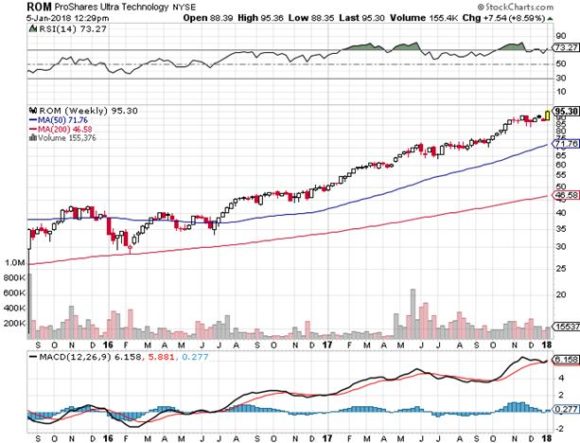
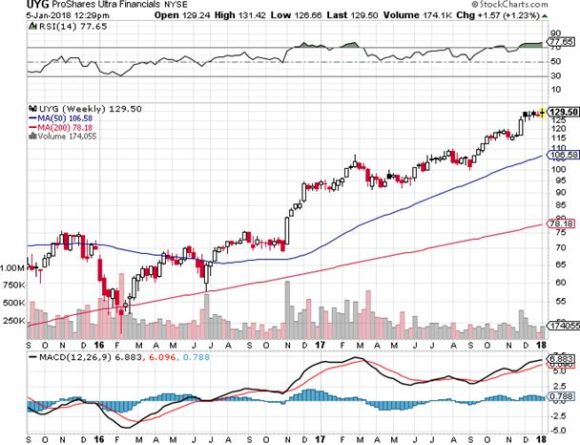
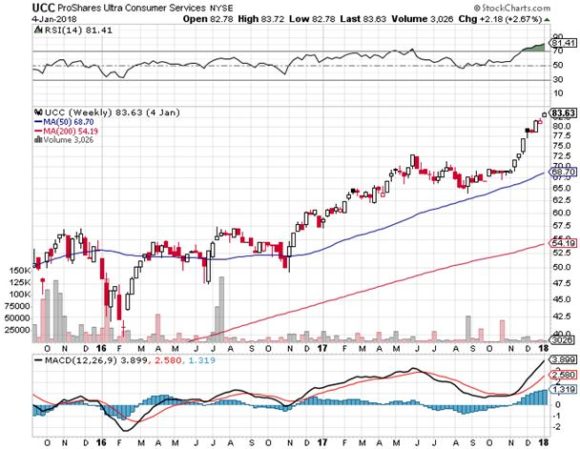
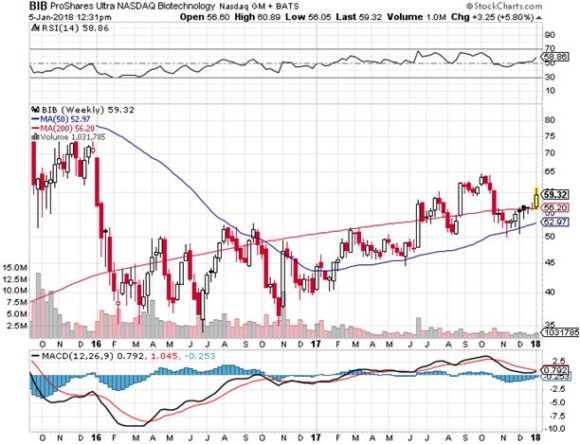
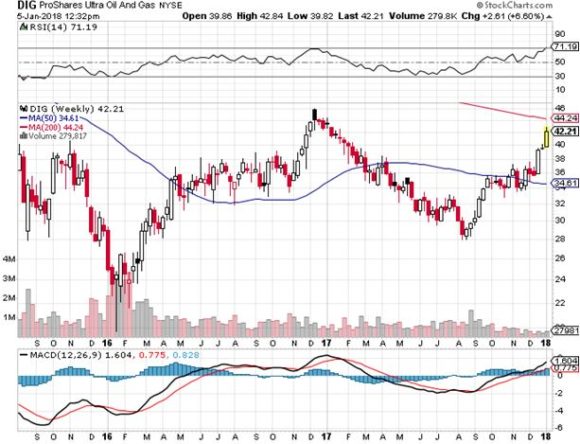
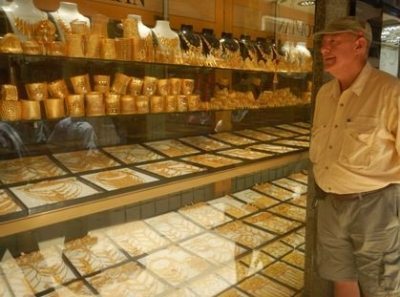
I have long advocated my ?Buy and Forget? portfolio for those who are terrible at trading.
This is where you buy just six self hedging, counterbalancing exchange traded funds and then rebalance once a year (click here for the article).
But what if you want to be a little more aggressive, say twice as aggressive? What if markets don?t deliver any year on year change, as they have done this year?
Then you need a little more juice in your portfolio, and some extra leverage to earn your crust of bread and secure your retirement.
It turns out that I have just the solution for you. This would be my ?Passive/Aggressive Portfolio?.
I call it passive in that you just purchase these positions and leave them alone and not trade them. I call it aggressive as it involves a basket of 2x leveraged ETFs issued by ProShares, based in Bethesda, MD (click here for their site).
The volatility of this portfolio will be higher. But the returns will be double what you would get with an index fund, and possibly much more. It is a ?Do not open until 2035? kind of investment strategy.
Here is the makeup of the portfolio:
(ROM) ?- ProShares Ultra Technology Fund - The three largest single stock holdings are Apple (AAPL), Microsoft (MSFT), and Facebook (FB). It is up 13.7% so far this year. For more details on the fund, please click here: http://www.proshares.com/funds/rom_daily_holdings.html.
(UYG) ? ProShares Ultra Financials Fund - The three largest single stock holdings are Wells Fargo (WFC), Berkshire Hathaway (BRK.B), and JP Morgan Chase (JPM). It is up 6.2% so far this year. For more details on the fund, please click here: http://www.proshares.com/funds/uyg_index.html.
(UCC) ? ProShares Ultra Consumer Services Fund - The three largest single stock holdings are Amazon (AMZN), (Walt Disney), (DIS), and Home Depot (HD). It is up 18.3% so far this year. For more details on the fund, please click here: http://www.proshares.com/funds/ucc.html.
(DIG) -- ProShares Ultra Oil & Gas Fund - The three largest single stock holdings are ExxonMobil (XOM), Chevron (CVX), and Schlumberger (SLB). It is DOWN 38.2% so far this year. For more details on the fund, please click here: http://www.proshares.com/funds/dig.html.
(BIB) ? ProShares Ultra NASDAQ Biotechnology Fund ? The three largest single stock holdings are Amgen (AMGN), Regeneron (REGN), and Gilead Sciences (GILD). It is up 15% so far this year, but at one point (before the ?Sell in May and Go away? I widely advertised) it was up a positively stratospheric 64%. For more details on the fund, please click here; http://www.proshares.com/funds/bib.html.
You can play around with the sector mix at your own discretion. Just focus on the fastest growing sectors of the US economy, which the Mad Hedge Fund Trader does on a daily basis.
It is tempting to add more leveraged ETFs for sectors that are completely bombed out, like gold (UGL), which has pared 27% of its value in 2015, and commodities (UCD) which is off 15%.
But it is likely that these despised ETFs will move down before they move up, especially going into year end.
There is also the 2X short Treasury bond fund (TBT), which I have been trading in and out of for years, a bet that long-term bonds will go down, interest rates rise.
There are a couple of provisos to mention here.
This is absolutely NOT a portfolio you want to own going into a recession. So you will need to exercise some kind of market timing, however occasional.
The good news is that I make more money in bear markets than I do in bull markets because the volatility is higher. However, to benefit from this skill set, you have to keep reading the Diary of a Mad Hedge Fund Trader.
There is also a problem with leveraged ETFs in that management and other fees can be high, dealing spreads wide, and tracking errors huge.
This is why I am limiting the portfolio to 2X ETFs, and avoiding their much more costly and inefficient 3X cousins, which are really only good for intraday trading. The 3X ETFs are really just a broker enrichment vehicle.
There are also going to be certain days when you might want to just go out and watch a long movie, like Gone With the Wind, with an all ETF portfolio, rather than monitor their performance, no matter how temporary it may be.
A good example was the August 24 flash crash, when the complete absence of liquidity drove all of these funds to huge discounts to their asset values.
Check out the charts below, and you can see the damage that was wrought by high frequency traders on that cataclysmic day, down -53% in the case of the (ROM). Notice that all of these discounts disappeared within hours. It was really just a function of the pricing mechanism being broken.
I have found the portfolio above quite useful when close friends and family members ask me for stock tips for their retirement funds.
It was perfect for my daughter who won?t be tapping her teacher?s pension accounts for another 45 years, when I will be long gone. She mentions her blockbuster returns every time I see her, and she has only been in them for five years.
Imagine what technology, financial services, consumer discretionaries, biotechnology, and oil and gas will be worth then? It boggles the mind. My guess is up 100 fold from today?s levels.
You won?t want to put all of your money into a single portfolio like this. But it might be worth carving out 10% of your capital and just leaving it there.
That will certainly be a recommendation for financial advisors besieged with clients complaining about paying high fees for negative returns in a year that is unchanged, or up only 1%-2%. Virtually everyone has them right now.
Adding some spice, and a little leverage to their portfolios might be just the ticket for them.
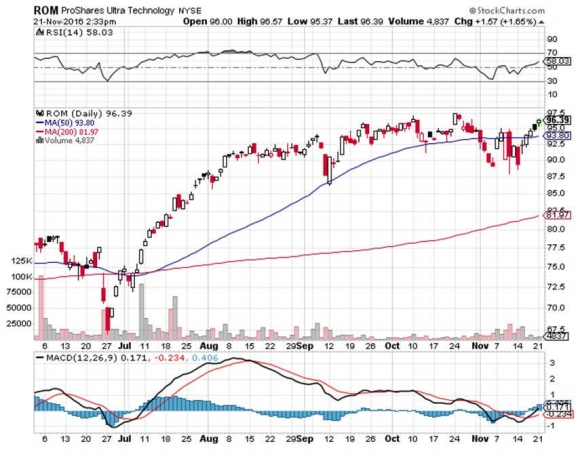
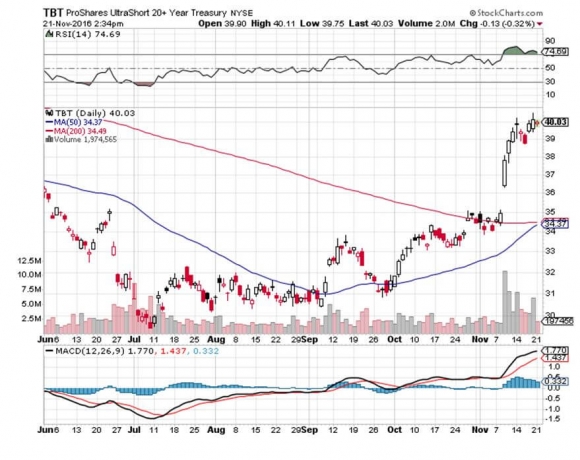
 It?s Time to Spice Up Your Portfolio
It?s Time to Spice Up Your PortfolioSince I am in a major patting myself on the back mood, I thought I would rerun a piece I ran last October entitled ?Apple is Ready to Explode?. This is back when the shares were trading at a lowly $490 a share.
Since then I have been urging readers to get in on the long side at every opportunity. They are now up a mind boggling 43% from that timely recommendation. They are laughing all the way to the bank.
?You have to be impressed how Apple shares have been trading during the Washington shutdown and the debt ceiling crisis. While other highflying technology stocks have crashed and burned, Apple has held like the Rock of Gibraltar.
Is this presaging much better things to come?
After the bar was set extremely low in the run up to the iPhone 5s launch, there has been an onslaught of good news. The first weekend sales came in at a staggering 9 million units, nearly double analyst forecasts. That?s a lot of units to be wrong by.
This has led to a series of broker upgrades by Cantor Fitzgerald, Cowen & Co., Piper Jaffray, Sanford Bernstein, and most recently by Jeffries. Entrenched bears are slowly an inexorably turning into bulls. Targets range up to $780.
During the summer, when the shares were trading in the low $400?s, Apple emerged as the largest buyer of its own stock. Still, it only made a dent in the $60 billion the company has dedicated to the program.
Of course, corporate raider and green mailer Carl Icahn (he lived in my building in Manhattan and was always a bit of a jerk) wants Apple to buy $160 billion of its stock, about $36% of the total market capitalization. But with a position of only $2 billion, Carl doesn?t have enough skin in the game to get anything more than a free dinner from CEO Tim Cook.
Still, the more Icahn bangs the drum about the value of Apple, the more money he sucks in. His blustering has probably added about $50 to the stock price. That works for me.
Like the Origin of the Universe and the 105-year long losing streak suffered by the Chicago Cubs baseball team, the cheapness of Apple shares is one of those mysteries that baffles investors. Sure, you?d expect some natural profit taking after the meteoric 15 year run in the shares, from $4 to $707. But a 46% drawdown is a lot, and many would say too much.
The company has eye popping net profits of $3.5 million per business hour (click here for the most recently quarterly announcement). Some one third of it capitalization, or $150 billion, sits in cash in European bank accounts.
That works out to $165 of the current $490 share price. This brings the ex cash trailing price earnings multiple down to a subterranean 11.8 times, or a 25% discount to the 16X market multiple. The dividend yield of 2.5% still exceeds that of the ten year Treasury bond. This is absurdly cheap.
Anyone who makes their living looking at the numbers has been loading up on the stock for the past eight months. Even permabear and short seller, Jim Chanos, has been buying on the theory that both Apple, and competitor Samsumg, together have been demolishing the Wintel architecture.
I think there is something important going on here. Apple is bringing out the next generation iPad in two weeks. Product refreshes for the iMac, Macbook, and Airbook in coming months are already well known. Every time an announcement of an announcement is made, the stock spikes $10.
But the 800-pound gorilla in Apples earnings stream is the iPhone, which accounts for more than 70% of its profits. The wildly successful 5s and 5c launches will take total smart phone sales from around 36 million in Q3 to at least 56 million units in Q4. The analyst community is nowhere near these numbers, so they are substantially underestimated the profitability of the company.
Apple has already cracked the China market for cash buyers with the latest upgrade of its wireless operating system. The whale here is a deal with China Mobile (CHL) with its 740 million customers, which has been to subject to on again and off again negations for years. Still, Apple has already told its manufacturers to add china Mobile to its approved carrier list.
I think the stock is beginning to discount the launch of the iPhone 6, which is still a distant 11 months away. That will take the company another generation ahead, with an expansive six-inch screen and a blazing fast A8 processor, leaving competitors in the dust.
The business is so big that my favorite airline, Virgin America, has initiated nonstop service from San Francisco to Austin. I?m told the plane is always full. That?s where they make processors for the new phones.
All of this leads me to believe that Apple will be a major mover in 2014. The chip shot is $600, and we get a real head of steam into the iPhone 6 rollout, we could match the old high at $707.
You can buy the stock here with some comfort. If you are hyper aggressive, try playing the weekly call options on the next breakout. The more cautious can settle for the Technology Select Sector SPDR ETF (XLK), or the ProShares Ultra Technology 2X leveraged ETF (ROM). Apple has major weightings in both of these ETF?s.?
For the link to the original story, please click here.
 So Where is the Power Button on this Thing?
So Where is the Power Button on this Thing?You have to be impressed how Apple shares have been trading during the Washington shutdown and the debt ceiling crisis. While other highflying technology stocks have crashed and burned, Apple has held like the Rock of Gibraltar. Is this presaging much better things to come?
After the bar was set extremely low in the run up to the iPhone 5s launch, there has been an onslaught of good news. The first weekend sales came in at a staggering 9 million units, nearly double analyst forecasts. That?s a lot of units to be wrong by.
This has led to a series of broker upgrades by Cantor Fitzgerald, Cowen & Co., Piper Jaffray, Sanford Bernstein, and most recently by Jeffries. Entrenched bears are slowly an inexorably turning into bulls. Targets range up to $780.
During the summer, when the shares were trading in the low $400?s, Apple emerged as the largest buyer of its own stock. Still, it only made a dent in the $60 billion the company has dedicated to the program.
Of course, corporate raider and green mailer Carl Icahn (he lived in my building in Manhattan and was always a bit of a jerk) wants Apple to buy $160 billion of its stock, about $36% of the total market capitalization. But with a position of only $2 billion, Carl doesn?t have enough skin in the game to get anything more than a free dinner from CEO Tim Cook. Still, the more Icahn bangs the drum about the value of Apple, the more money he sucks in. His blustering has probably added about $50 to the stock price. That works for me.
Like the Origin of the Universe and the 105-year long losing streak suffered by the Chicago Cubs baseball team, the cheapness of Apple shares is one of those mysteries that baffle investors. Sure, you?d expect some natural profit taking after the meteoric 15 year run in the shares, from $4 to $707. But 46% is a lot, and many would say too much.
The company earns an eye popping net profits of $3.5 million per business hour (click here for the most recent quarterly announcement). Some one-third of it capitalization, or $150 billion, sits in cash in European bank accounts. That works out to $165 of the current $490 share price. This brings the ex cash trailing price earnings multiple down to a subterranean 11.8 times, or a 25% discount to the 16X market multiple. The dividend yield of 2.5% still exceeds that of the ten year Treasury bond. This is absurdly cheap.
Anyone who makes their living looking at the numbers has been loading up on the stock for the past eight months. Even permabear and short seller, Jim Chanos, has been buying on the theory that both Apple and competitor Samsumg together have been demolishing the Wintel architecture.
I think there is something important going on here. Apple is bringing out the next generation iPad in two weeks. Product refreshes for the iMac, Macbook, and Airbook in coming months are already well known. Every time an announcement of an announcement is made, the stock spikes $10.
But the 800-pound gorilla in Apples earnings stream is the iPhone, which accounts for more than 70% of its profits. The wildly successful 5s and 5c launches will take total smart phone sales from around 36 million in Q3 to at least 56 million units in Q4. The analyst community is nowhere near these numbers, so they are substantially underestimating the profitability of the company.
Apple has already cracked the China market for cash buyers with the latest upgrade of its wireless operating system. The whale here is a deal with China Mobile (CHL) with its 740 million customers, which has been to subject to on again and off again negations for years. Still, Apple has already told its manufacturers to add China Mobile to its approved carrier list.
I think the stock is beginning to discount pending the launch of the iPhone 6, which is still a distant 11 months away. That will take the company another generation ahead, with an expansive six-inch screen and a blazing fast A8 processor, leaving competitors in the dust. The business is so big that my favorite airline, Virgin America, has initiated nonstop service from San Francisco to Austin. I?m told the plane is always full.
All of this leads me to believe that Apple will be a major mover in 2014. The chip shot is $600, and we get a real head of steam into the iPhone 6 rollout, we could match the old high at $707. You can buy the stock here with some conform. If you are hyper aggressive, try playing the weekly call options on the next breakout. The more cautious can settle for the Technology Select Sector SPDR ETF (XLK), or the ProShares Ultra Technology 2X leveraged ETF (ROM). Apple has major weightings in both of these ETF?s.
 So Where is the Power Button On This Thing?
So Where is the Power Button On This Thing?Legal Disclaimer
There is a very high degree of risk involved in trading. Past results are not indicative of future returns. MadHedgeFundTrader.com and all individuals affiliated with this site assume no responsibilities for your trading and investment results. The indicators, strategies, columns, articles and all other features are for educational purposes only and should not be construed as investment advice. Information for futures trading observations are obtained from sources believed to be reliable, but we do not warrant its completeness or accuracy, or warrant any results from the use of the information. Your use of the trading observations is entirely at your own risk and it is your sole responsibility to evaluate the accuracy, completeness and usefulness of the information. You must assess the risk of any trade with your broker and make your own independent decisions regarding any securities mentioned herein. Affiliates of MadHedgeFundTrader.com may have a position or effect transactions in the securities described herein (or options thereon) and/or otherwise employ trading strategies that may be consistent or inconsistent with the provided strategies.
This site uses cookies. By continuing to browse the site, you are agreeing to our use of cookies.
OKLearn moreWe may request cookies to be set on your device. We use cookies to let us know when you visit our websites, how you interact with us, to enrich your user experience, and to customize your relationship with our website.
Click on the different category headings to find out more. You can also change some of your preferences. Note that blocking some types of cookies may impact your experience on our websites and the services we are able to offer.
These cookies are strictly necessary to provide you with services available through our website and to use some of its features.
Because these cookies are strictly necessary to deliver the website, refuseing them will have impact how our site functions. You always can block or delete cookies by changing your browser settings and force blocking all cookies on this website. But this will always prompt you to accept/refuse cookies when revisiting our site.
We fully respect if you want to refuse cookies but to avoid asking you again and again kindly allow us to store a cookie for that. You are free to opt out any time or opt in for other cookies to get a better experience. If you refuse cookies we will remove all set cookies in our domain.
We provide you with a list of stored cookies on your computer in our domain so you can check what we stored. Due to security reasons we are not able to show or modify cookies from other domains. You can check these in your browser security settings.
These cookies collect information that is used either in aggregate form to help us understand how our website is being used or how effective our marketing campaigns are, or to help us customize our website and application for you in order to enhance your experience.
If you do not want that we track your visist to our site you can disable tracking in your browser here:
We also use different external services like Google Webfonts, Google Maps, and external Video providers. Since these providers may collect personal data like your IP address we allow you to block them here. Please be aware that this might heavily reduce the functionality and appearance of our site. Changes will take effect once you reload the page.
Google Webfont Settings:
Google Map Settings:
Vimeo and Youtube video embeds:
